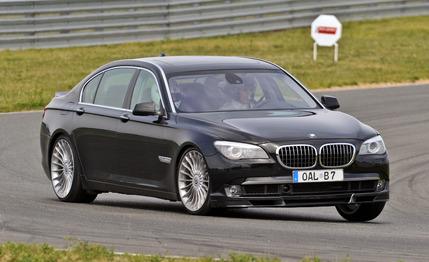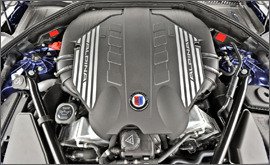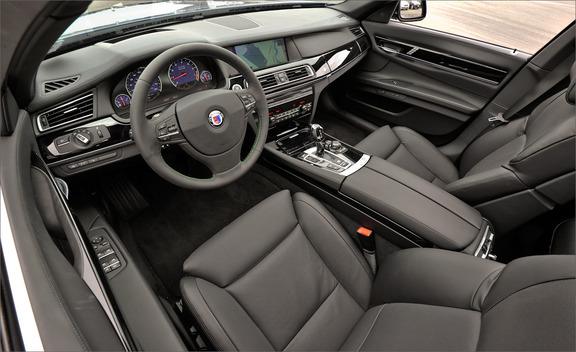
 First Drive Review
First Drive Review
For readers who aren’t totally steeped in BMW lore, the Alpina name might be a bit of a mystery. But it’s a pretty simple one to clear up: Alpina is to BMW what AMG used to be to Mercedes-Benz: an independent racing and tuning shop that has factory approval. (AMG is now wholly owned by Mercedes, however.) Alpina, for instance, co-developed the fabulous 3.0 CSL coupe with BMW in the early 1970s and is formally recognized as an automobile manufacturer by the German federal agency.
Alpina caught the eyes of the American market primarily with two cars: the Alpina roadster V-8 that was imported beginning in 2003 and the Alpina B7 that was sold in the U.S. from 2007 to 2009. Based on the previous-generation E65 7-series, the B7 sold 748 units here.
BMW and Alpina are hoping the new B7 will do better, especially since it is coming to the U.S. just a year after the current F01 (F02 for long-wheelbase cars) 7-series platform went on sale in early 2009. They are aiming to sell 500 cars a year in the U.S., out of an overall production of 1000 to 1500 annually. This would vault the U.S. into position as the largest market in the world for Alpina, which says its mission isn’t quite as hard core as AMG’s. Its target is the Jaguar R-series, where the emphasis is on marrying great cornering performance with good ride quality.


Alpina takes long- and short-wheelbase 750 BMWs, with or without xDrive all-wheel-drive, and thoroughly massages them. The 4.4-liter V-8 engine gets bigger turbochargers, reinforced cylinder heads, high-performance pistons, and Alpina software. The maximum boost pressure is raised to 14.5 psi, which helps to lift output from 400 hp and 450 lb-ft of torque to 500 and 516, respectively. These numbers are identical to those of the old B7’s supercharged engine, but the torque is generated at 3000 rpm, 1250 revs lower. To cope with the extra heat generated by its upgrades, Alpina fits an additional radiator and engine-oil cooler, an external transmission-oil cooler, a higher-performing fan, and larger-capacity intercoolers with larger-diameter water lines.
The car gets a beefed-up version of the 7-series’ ZF six-speed automatic. Manual shifting is effected by buttons on the back of the steering wheel—right for upshifts, left for down. The driveshaft and the half-shafts are reinforced, and a stiffer iron differential case is fitted in place of the 7-series’ aluminum housing.
The chassis also comes in for attention. The spring rates are stiffened by about 20 percent, the front and rear ride heights are reduced by 0.6 and 0.4 inch, respectively, and the traction- and stability-control settings are tweaked. Alpina fits 21-inch wheels on all versions, but only the rear-drive, short-wheelbase car gets the sticky Michelin Pilot Sport PS2 tires in staggered sizes: 245/35 up front and 285/30 out back. The brakes are the biggest in BMW’s inventory, sourced from the armored 7-series protection package. Overall, Alpina says the new car weighs 4564 pounds in short-wheelbase, rear-drive form.
Whether long- or short-wheelbase, the B7 is a handsome device, the 7-series’ demeanor enhanced by its lowered stance and those utterly gorgeous wheels. Other exterior changes are unique exhaust tips, a different front spoiler and fascia that incorporate three additional intakes for cooling, and a different rear valance and trunk spoiler. Alpina says the rear spoiler reduces lift by 15 percent at 87 mph and the front one is responsible for a 30-percent reduction. Inside, there are blue-illuminated sill plates, a hand-stitched Lavalina leather steering wheel, unique piano black or myrtle burl-walnut trim, an Alpina gauge cluster, and lots of Alpina logos.
We sampled B7s on road and track and can report that they are way sportier than a 750i or 750Li but don’t have the hard-edged character of an S63 Mercedes. The engine unleashes waves of torque all the way up the rev range but is quiet and unobtrusive unless you bury your foot to the firewall, when it makes a stirring, gruff growl. BMW claims 0 to 60 mph takes 4.5 seconds, with an added 0.1 second for the all-wheel-drive versions. Top speed is governed to 175 mph, which is 12 mph down on the previous car’s maximum. The EPA estimates 14 mpg in the city for all cars. Rear-drivers are quoted at 21 mpg on the highway, with the xDrive models at 20.


On the street, the car rides superbly in comfort mode—just like a regular 7-series, there are comfort, normal, sport, and sport-plus chassis and drivetrain settings—and is very well damped even in sport plus. As with a regular 7-series, we prefer the extra weight of the steering in the sport settings. Although the buttons work really well for manual shifts, they’re almost superfluous in a car with this much torque unless you’re planning to go to a track, which we don’t think is that likely for the vast majority of the owner body.
However, we did experience the B7 on the track in wet and dry conditions and can report that it’s really impressive for such a big vehicle. The body motions are well controlled, and it turns in to corners with an enthusiasm that seems at odds with its size and weight. With the stability system off, it’s possible to get big oversteery moments, but the car is generally well behaved. Compared with a 750Li, there’s less initial understeer and the B7 corners with a flatter, more neutral stance. The brakes are superb, imparting much more confidence than the binders on a 750Li we tried.
The B7 starts at $124,175, including gas-guzzler tax. The long-wheelbase model costs $3900 extra, and all-wheel-drive adds $3000 to either. Options include active cruise control ($2400); night vision ($2600); a tech package bundling lane-departure warning, active headlamps, and blind-spot detection ($1350); a rear-seat entertainment system ($2200); and on long-wheelbase models only, ventilated and massaging rear seats ($3700). The B7 costs $40,000 more than a 750i—still about $16,000 less than the long-wheelbase-only V-12–powered 760Li—but the long-wheelbase version undercuts the S63 AMG by $9350. We’re never quite sure why luxury-car owners feel the need to buy sportier versions of luxury liners, but the B7 strikes us as a nice compromise, even if it lacks the grittiness of the AMG machine.